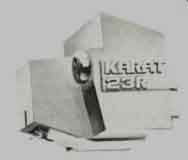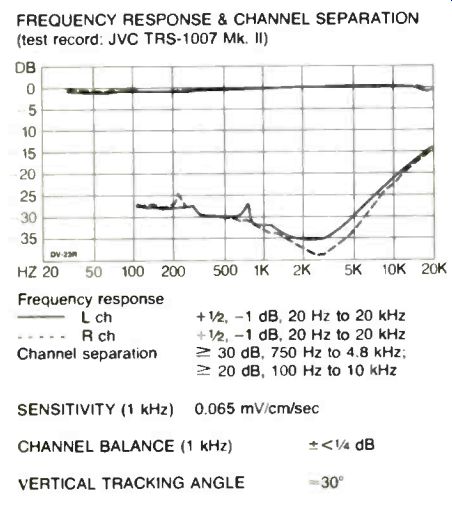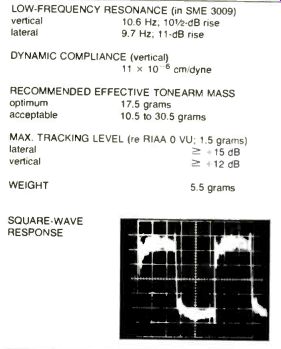
A Polished Gem from Dynavector
Dynavector DV-23R moving-coil phono pickup, with ruby cantilever and "super elliptical" diamond stylus.
Price: $310. Warranty: "limited," one year parts and labor. Replacement cartridge: $170. Manufacturer: Dynavector Systems, Ltd. Japan: U.S. distributor: Dynavector Systems USA, 1721 Newport Circle, Santa Ana, Calif. 92705.

FREQUENCY RESPONSE 8 CHANNEL SEPARATION (test record: JVC TRS-1007
Mk. II)
--------------------------
Tonearm/Cartridge Matching Graph
By means of this nomograph, you can quickly and easily determine the compatibility of any cartridge and tonearm we have tested. Ideally, the arm/cartridge resonance frequency (indicated by the diagonal lines) should fall at 10 Hz, but anywhere between 8 and 12 Hz will assure good warp tracking and accurate bass response. (It is usually okay to let the resonance rise as high as 15 Hz, although we don't normally recommend this.) Begin by looking up the weight and dynamic compliance shown in the cartridge report and the effective mass listed in the turntable or tonearm report. Add the weight of the cartridge to the effective mass of the tonearm to get the total effective mass. Then find the point on the graph where the vertical line for the total effective mass intersects the horizontal line for the cartridge's dynamic compliance. For a good match, this point should fall in the white region, between the 8-and 12-Hz diagonal lines.
When necessary, you can back-figure compliances and effective masses for cartridges and tonearms tested before we began reporting these figures directly (in January 1983). For cartridges, look up the vertical resonance frequency (measured in the SME 3009 Series II Improved tonearm) and the cartridge's weight. Add 15 grams (the SME's effective mass) to the cartridge weight to get the total effective mass. Then find the intersection of the vertical line representing that mass with the diagonal line representing the measured resonance frequency. Now you can read off the compliance from the horizontal line passing through the point of inter section.
For tonearms, look up the vertical resonance frequency as measured with the Shure V-15 Type III cartridge. Find the inter section of the diagonal line for that frequency with the horizontal line representing the Shure's dynamic compliance of 22.5 x 10^-6 cm/dyne. Reading down the vertical line on which the point of intersection lies will give you the total effective mass of the arm with the Shure V-15 Type III mounted in it. Then subtract 6.3 grams (the weight of the V-15 Type III) to get the tonearm's effective mass.
Because of differences in measurement techniques, manufacturers' specifications for compliance and effective mass often differ from our findings and may therefore yield inconsistent results if used with this graph.

------------------
IT'S HARD TO RESIST labeling this cartridge "a jewel of a pickup" in recognition of its ruby cantilever. Jewel cantilevers are not new: Dynavector introduced a model with a diamond cantilever in 1979, and B&O used sapphire for the purpose at nearly the same time. Since then, a number of other manufacturers, including ADC, Grace, and Klipsch have followed suit. The reason for using such exotic (and expensive) materials is to transmit the recorded waveform from the stylus tip to the transducer within the pickup as perfectly as possible, free from the mechanical distortion that can be imposed by an insufficiently stiff cantilever. Specifically, Dynavector says it has chosen ruby to minimize dispersion of the transverse wave propagated along the cantilever, without sacrificing conventional performance characteristics, such as frequency response and channel separation.
The DV/Karat 23 Ruby, better known as the DV-23R, is a typically low-output moving-coil model, requiring the use of either a step-up transformer or a pre-preamp ahead of the phono preamp. (Both methods proved entirely satisfactory in our tests.) The tip shape is described as "super elliptical." Apparently it splits the difference between the "fatter" spherical and elliptical shapes required by the high vertical tracking forces of some moving-coil models and the small-curvature multi-radials favored for light-tracking fixed-coil models. The DV-23R's recommended tracking force is 1 1/2 grams-not much higher than the 1 to 1 1/4 grams typical of high quality fixed-coil pickups.
The cartridge's response is certainly flat. Indeed, all of the conventional measurements are excellent. Vertical tracking angle (as measured with the DIN twin-tone test cuts) is on the high side of the specified 20 degrees, as it is with many top pickups.
In the low-frequency test, the highest-VTA band (30 degrees) proved the best match to the pickup; at the high test frequencies, the 25-degree band supplied the best match.
When Diversified Science Laboratories measured maximum lateral tracking levels, the 23R had no trouble with the highest band (+ 18 dB RIAA) at 200 Hz, but couldn't manage at 400 Hz, settling for +15 dB instead-which still is more than you'll usually need.
The low-frequency resonance is just about ideally placed in the SME arm. From now on, however, we will be talking more about the dynamic compliance and the effective tonearm mass with which it should be mated. Low-frequency dynamic compliance-measured at 11 (x 10^-6 centimeters per dynes by DSL for the DV-23R-bears no necessary relationship to the static compliance frequently listed by manufacturers.
(Dynavector gives a "compliance" spec of 15, without saying how it was measured.) But it is low-frequency dynamic compliance that governs actual resonance and therefore susceptibility to warps. Both the resonance measurement and the tendency for compliance to run lower in moving-coil pickups than in current fixed-coil models would lead us to expect higher compliance numbers in future tests-and lower ideal arm masses. Suffice it to say here that these figures confirm that the Dynavector should do well in a relatively broad spectrum of arms, from fairly low to fairly high in mass, with a moderately heavy arm such as our SME just about on target. (For a full discussion of this subject, see "Basically Speaking," page 25.) It is in the listening room that the Dynavector really shines, however. We had expected superb smoothness and excellent clarity, and we weren't disappointed. In none of our listening could we discern a significant falsification of timbre. From tri angle to tympani, from trombone to piccolo, reproduction is exemplary in its faithfulness. Voices and strings suffer from no edginess or breathiness. Some listeners detected a very slight "glassiness" in complex passages, but none of our auditioning revealed any shortcoming that might be associated with the failure to track the ultra high-level 400-Hz test band.
On the contrary, the most imposing thing about this pickup is its dynamic range. Perhaps because of it's superb way with transients, the DV-23R seems to reproduce a greater difference between the loudest and the softest passages on given records than we are used to hearing with other pickups. When we tried the crushing crescendi at the beginning of Side 2 of the Sheffield Lab Romeo and Juliet (Leinsdorf s editing of the Prokofiev ballet), the impact was devastating. The Dynavector's very solid bass surely contributes to this effect, which is at once visceral and delicately detailed. We are satisfied that the DV-23R is one of the world's great phono cartridges.

------
(High Fidelity, Jan. 1983)
Also see:
Boston Acoustics MC-1vdH moving-coil phono cartridge (Equip. Report, Jan 1983)